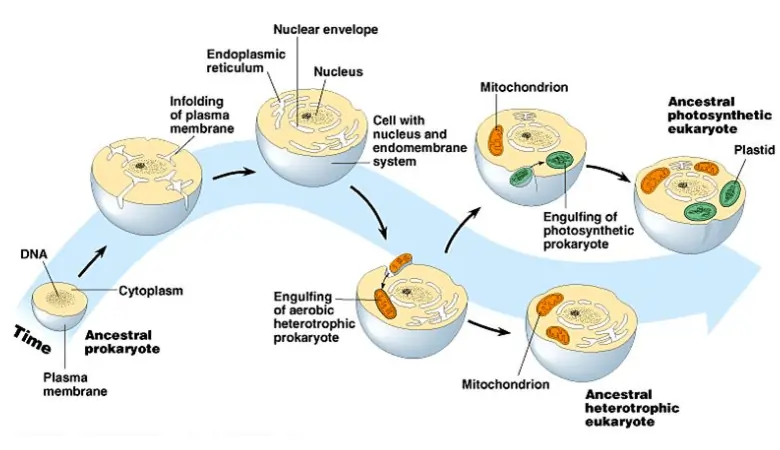Though sometimes dull, biology has taught us about many thought-provoking phenomena occurring within us and our vicinity. The most cardinal concept within this many concepts is named endosymbiotic theory of the origin of eukaryotic cells; let us talk about symbiosis. The term symbiosis has a Greek origin, which has a literal meaning; living together. Symbiosis refers to a close relationship between two living cells in which either both or just one gets benefitted. Some common examples of symbiosis include mutualism, commensalism, parasitism, etc. Let us move on to our topic of interest, i.e. endosymbiosis.
Endosymbiosis
The term endosymbiosis has set its root within the Greek vocabulary. It means to live within. According to the normal vanilla endosymbiosis definition, it is a symbiotic phenomenon in which two living cells live together to benefit each other mutually, but under the constraint that one will have to live within the other. An example of an endosymbiotic relationship includes Rhizobia, wherein the nitrogen-fixing bacterium lives within the root nodules of leguminous plants to benefit each other. Endosymbiosis might seem like most of the other conventional phenomena of the biological sciences, but it is the pedestal of a highly critical phenomenon; the Endosymbiotic theory of the origin of eukaryotic cells. The endosymbiotic theory is another very complex yet interesting theory within the life sciences. More about the endosymbiotic approach is mentioned in the below section of the blog.
Explain the Endosymbiotic Theory of the Origin of Eukaryotic Cells
This theory is a very well-known theory which describes the way organisms arose and evolved. It also differentiates the eukaryotes from the prokaryotes. The endosymbiotic theory of the origin of eukaryotic cells states that all individuals grew from the same individual. Following the endosymbiotic view of the origin of eukaryotic cells, eukaryotes have evolved from several cells that joined together and formed a single eukaryotic cell.
Now that we are on the verge of discussing the endosymbiotic theory for the origin of eukaryotes, it is essential to state what endosymbiosis is. Endosymbiosis is the process in which one organism lives within the other, and the endosymbiont is the organism that lives within the other organism. Per the endosymbiotic theory, every eukaryotic cell we see today comprises several different partitions that were once whole in themselves.
It is believed that both chloroplast and mitochondrion were once free, living, complete beings or cells. According to the endosymbiotic theory, both were prokaryotes that lived endosymbiotically in some other host, and they happened to join the host cell through phagocytosis or by some other means. That eventually led to forming the eukaryotic cell, which evolved from an endosymbiotic relationship. Instead of killing the host cell or getting digested by it, these organelles lived comfortably. The host cell provided these organelles with a safe place to thrive, and in return, the organelles worked and provided good energy to the host cell.
According to the endosymbiotic theory of the origin of eukaryotic cells, this entire event happened a long time ago. Since then, the host and the endosymbiont have been evolving together, and now they are one single eukaryotic cell or organism composed of multiple such types of cells. It is believed that it is impossible to sustain freely within the environment, leading to the evolution of the eukaryotes. Although we still find evidence of free-living organisms.
Evidence of Endosymbiosis
The endosymbiosis evidence holds immense importance in the endosymbiotic theory of the origin of eukaryotic cells. There have been multiple pieces of endosymbiosis evidence to support the endosymbiotic theory, but only a few are considered and accepted by widely known scientists and researchers. In 1883 botany researcher Andreas Schimper observed something odd while looking at the plastids of a green plant. He observed that the plastids, or the chloroplasts in particular, were dividing independently, like that of a single bacterial cell.
Later, during the 1960s, a troop of scientists concluded that the mitochondria and the plastids present within a plant cell possess their DNAs. The DNAs found within these organelles were not similar to the ones of the plant cell. Closer examination proved that the genes of the mitochondria and the plastids resembled that of the prokaryotes. Hence, the cell organelles within the eukaryotic cell are related to the prokaryotes.
Hence, according to this evidence of endosymbiosis, it is believed that the eukaryotes evolved due to symbiosis; therefore, the endosymbiotic theory holds. The eukaryotes' cell organelles resemble modern prokaryotic cells and have their genetic material. Hence, the eukaryotes evolved from freely living cells once in an endosymbiotic relationship with the other.
Although numerous pieces of evidence support the Endosymbiotic theory of the origin of eukaryotic cells, a few theories and pieces of evidence have been evoked against it. Hence, the Endosymbiotic theory of the origin of eukaryotic cells is the most controverted and discussed. The majority of evidence is actually in support of the endosymbiotic theory of the origin of eukaryotic cells.



